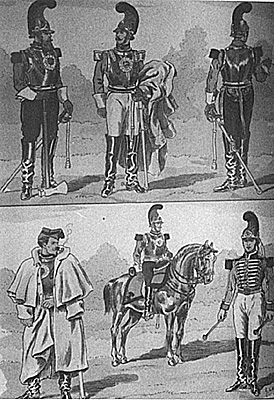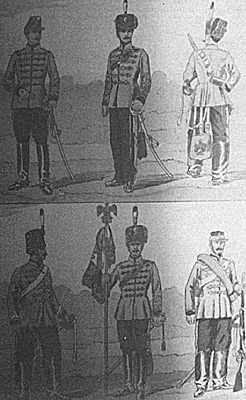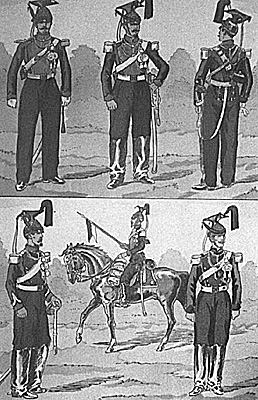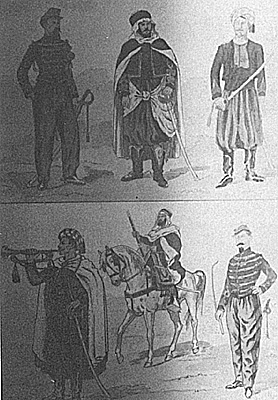 Chasseurs a Cheval in green dolman. This same general uniform was worn by most chasseurs in all of Napoleon III's wars.
Chasseurs a Cheval in green dolman. This same general uniform was worn by most chasseurs in all of Napoleon III's wars.
At the start of the Empire, all of the traditional types of cavalry were on hand. There were two carabinier regiments, with their light blue coals and bronzed armor, 8 of cuirassiers with polished iron armor and dark blue coats, raised to 10; and up to 12 regiments of dragoons; 8 lancer units, 8 of hussars, 12 of chasseurs, and 4 of chasseurs d'Afrique and 3 of spahis. The Guard originally consisted of 2 cuirassiers, 1 lancer, 1 dragoon, 1 guide,and 1 chasseur a cheval at full strength, but the 2nd cuirassiers of the guard were abolished in 1865, and, after the disbanding of the carabiniers in 1867, a Garde Carabinier regiment was raised.
In dealing with the heavy cavalry, especially the cuirassiers and carahiniers, we could dispense with those of the line when it comes to combat uniforms in the campaigns before 1870. Like the Austrian cuirassiers, they sat out the 1859 war, not to mention the Crimean War. They were too important to be sent to places like Mexico or North Africa - or perhaps too impractical. That would simplify matters, for while the original 8 cuirassier regiments had varied facing and trim colors up to 1860, at that time they adopted a blue tunic with madder red collar, cuff patches, and scarlet epaulettes as always with the madder red overalls. The regimental number was worn on the collar. Buttons were white metal. The shabraque was dark blue trimmed white. The helmet had a black turban and horse hair plume, red aigrette, brass comb and chin scales. The tunic was usually worn turned back showing red.
A case could be made that the dragoons, who abandoned their traditional green uniform in 1867 (except for the Guard Dragoons, or Dragoons de l'Emperatrice) saw some action. They did not go to Italy, or North Africa, nor to Mexico.
 Carabiniers of the line. Shabraque is, like the coat, light blue. Trousers red except for full dress. Breastplate brass with silver rays on gold sun. Epaulettes madder red, same for plume. Guard regiment similar.
Carabiniers of the line. Shabraque is, like the coat, light blue. Trousers red except for full dress. Breastplate brass with silver rays on gold sun. Epaulettes madder red, same for plume. Guard regiment similar.
At least 2 regiments got into the last stages of the Crimean War. Therefore, it is noted that the coat was green, double-breasted, with plastron worn at least in full dress. The coat was turned back. The helmet was of yellow metal with leopard skin (probably fake) turban, red aigrette, red epaulettes, madder red trousers. Trumpeters had white epaulettes and red horsehair plumes (instead of black). Button color was yellow metal. Colors were as follows:
DRAGOONS
| Regt | Collar, Lapels and Piping | Cuff Patches | Cuffs | Crescents |
|---|---|---|---|---|
| 1,2 | dark pink | dark pink | green | green |
| 3,4 | green | green | dark pink | dark pink |
| 5,6 | yellow | yellow | green | green |
| 7,8 | yellow | green | yellow | yellow |
| 9,10 | carmine | carmine | green | green |
The dragoons of the Guard, who actually went on campaign in 1859, but are not certain to have actually fought anyone at Ihat time, wore a green jacket with red collar, white lapels, epaulettes, aiguilettes and leather equipment. The jacket is described as light green, but I think I have seen it in at leasta medium green. Unlike the line, whose cuffs were more or less of the brandenburg style,the Guard had pointed cuffs. Turnbacks were of coat color with red piping and grenades. Buttons were yellow metal. Officers had gold epaulettes and trouser stripes, while those of the troopers had double green stripes.
Line dragoons are usually shown with no stripes on the trousers. When styles changed to single breasted blue tunics with white collar and cuff flaps and piping, the Guards stuck to their former colors. In 1870 the Empress Dragoons distinguished themselves by charging their own brigade mates, the Guard Lancers at the great cavalry fight of Vionville. One English correspondent blamed it on the lancers, who should have been charging faster and put themselves out of danger. The lancers, by the way, wore white kurtka with blue plastron in full dress, but light blue piped white in the field. This is said to have made them look like Bavarian uhlans.
McClellan, who reported on the Armies of Europe between the Crimean War and the Italian Campaign, stated that the lancers carried a musketoon, which would possibly be abandoned. The hussars carried a similar weapon, but the dragoons and chasseurs a cheval carried a musket, which was worn attached to the saddle in the traditional muzzle up position, then was strapped to the rider's back by the musketsling when the enemy was in sight.
That arrangement is certainly plausible, and, of course, he was there. But while the dragoons are so depicted in contemporary pictures, the chasseursa cheval, who wore a natty green dolman with black lace loops, madder red trousers with double green stripes, and a black fur cap, are almost always shown with a typical cavalry carbine (musketoon) slung muzzle down. The chasseurs ~ cheval d'Afrique, on the other hand, are frequently depicted in action with the weapon strapped on their backs, and in many cases it appears to be a full length weapon.
A print on North American Military Uniforms put out by the Military Collectors of America depicts a Chasseur a Cheval d'Afrique in Mexico with a model 1842 percussion musket on his back. That smooth bore weapon is a marked contrast to the material carried by the U.S. Cavalry in the Army of Observation about to move down to the Rio Grande. (An interesting 'what if?' scenario here - ED). However, the model 1842 is identical in appearance to the 1842T,which had been rebored to take Minie balls. It is therefore possible thatat some point priorto 1867 the Chasseursa Cheval d'Afrique had at least a rifled shoulder arm. During his tour, McClellan noted that provision was made for target practice at the French cavalry schools, but the musket was inordinately difficult to use mounted, while the musketoon (carbine) was depressingly inaccurate. Fortunately, within theireffective range, the saberand lance were fairly accurate if notalways possessed of lethal velocity.
The Chasseurs a Cheval d'Afrique regiments, originally intended to be lancers, adopted in 1833 a light blue coatand madder red trousers topped with a red kepi with light blue band. In service the kepi was sometimes covered with the famous white cloth coverand neck cloth. The cuffs were pointed like those of the light infantry, yellow piped light blue in the ist, light blue piped yellow in the 2nd, with collar yellow in the 1st, light blue with yellow patch in the 2nd. The 3rd had a yellow collar with light blue patch and yellow pointed cuffs. The 4th, which lasted from 1839 to 1856, 7 had sky blue collars and pointed cuffs. In 1853 all regiments adopted yellow collars. The kepi was frequently stiffened into the sbape of a shako. In 1862 a light blue dolman with yellow collar and black loopings like those of the chasseurs a cheval was adopted. However, on active duty a simple light blue single breasted jacket with yellow collar and cuff patches, white trefoil, and red girdle was commonly worn. The shabraque was light blue with red trim, and the trousers were normally madder red decorated with double light blue stripes. These elite regiments served not only in North Africa, but in the Crimea, Mexico, Italy, and in the 1870 war. They escorted Napoleon III on his way to surrender -- a dubious but well intentioned honor for the survivors of the chevauchee la morte of Sedan.
The chasseurs of the line were almost as natty, with their short green jackets and black lace loops secured with a triple row of silver buttons, full red trousers with double dark green stripes and black false boots in service dress. The belting was white with brass fasteners, and separately secured the carbineand cartridge box - all the illustrations I have show a carbine - no matter what McClellan said. By our period of interest, regimental distinctions seem to have been reduced to collar piping, very brief turnbacks,and pointed cuff piping, but some may have retained the colored cuff. Knoetel gives the Uniform as a single breasted jacket with red fringed epaulettes from 1831 to 1858, when the red shako was replaced with a black fur cap and the laced dolman-like jacket.
Knoetel describes the latter as light green, but it is usually shown dark green. The small fur cap without bag and with a green plume topped red (only a squadron pomporn in service) was adopteclat that time, thus the uniform was in place by 1859 which would be worn in 1870. However, Knoetel states that the 1st, 6th and 9th regiments wore light blue with a single row of white metal buttons and six black lace loops (in place of 18) with collar and cuffs of sky blue with red piping. The distinctive colors earlier were:
| Regt | Collar | Cuffs |
|---|---|---|
| 1,2 | scarlet | green |
| 3,4 | green | scarlet |
| 5,6 | yellow | green |
| 7,8 | green | yellow |
| 9,10 | carmine | green |
| 11,12 | green | carmine |
The shabraque was the same green as the coat with red trim. From 1858 a black leather sabertache with a copper eagle badge was worn. The white overcoat was worn looped over the right shoulder. Musicians were distinguished only by white plumes topped red. A red kepi was sometimes worn by officers on active duty or as a fatigue cap.
Hussars, typically, were regular fashion plates. They even managed, for a time, to avoid standardizing on the pantalon rouge. On the eve of the revolutions, they were dressed as follows (from Knoetel):
| Regt | Dolman, Collar, Pelisse | Pelisse Edging |
Dolman Cuffs, Breeches,Shako | Lace |
|---|---|---|---|---|
| 1 | light blue | black fur | madder red | white |
| 2 | brown | black fur | light blue | white |
| 3 | gray | black fur | madder red | mixed (yellow?) |
| 4 | madder red | black fur | light blue | white |
| 5 | blue | black fur | madder red | mixed (yellow?) |
| 6 | green | black fur | madder red | mixed (yellow?) |
| 7 | green | gray fur | madder red | mixed (yellow?) |
| 8 | white | black | madder red | mixed (yellow?) |
| 9 | black | black | light blue | black |
 Hussars in the 1867-71 uniform. Light blue tunic, madder trousers. Officer wears covered kepi, troopers either busby or red kepi with light blue trim. Armed with saber and chassepot. Not all hussars had this new uniform.
Hussars in the 1867-71 uniform. Light blue tunic, madder trousers. Officer wears covered kepi, troopers either busby or red kepi with light blue trim. Armed with saber and chassepot. Not all hussars had this new uniform.
These snappy uniforms, with elite companies in full napoleonic busbys (at least for full dress, and trumpeters often in reversed colors) were still in vogue for the Italian war. However, the pelisse was usually either not worn or worn closed up. The 9th Regiment disbanded in 1856,and in 1860 all regiments adopted a black fur cap like that of thechasseurs, butwith a red bag and white and red plume. Also, all wore red trousers, and red collars and cuffs. The 1st and 8th had sky blue dolmans, the 2nd brown, the 3rd and 4th silver gray, the 5th dark blue, the 6th and 7th light green. The first 6 wore white lace loops, the rest yellow.
The 1867 reforms, which changed so many uniforms into a much simpler and more modern style also affected the hussars. The numerous lace loops were replaced with only 6, all tunics became sky blue, and the sabertache which had been varied by regiment became identical to that of the chasseurs (the chasseur pattern is shown by CoCitume Militaire Francaise with the earlier uniform). However, the change in regulations had not always taken by 1870. Some hussars probably arrived on the field of battle in the 1860 uniform. The shabraque seems to have been dolman color trimmed white.
Lancers
The 8 lancer regiments took the field mainly in 1859 and 1870. So far as I know, they did not go to Mexico and fight it out with Major Dundee. With the exception of the full red trousers, sometimes ending in black leather false boots, they resembled Uncle Napoleon's Polish Lancers.
 Lancers in the 1845-67 uniform. Although being supplanted with a single breasted tunic in 1868-70, it was still worn during the war by some regiments.
Lancers in the 1845-67 uniform. Although being supplanted with a single breasted tunic in 1868-70, it was still worn during the war by some regiments.
The czapska and kurtka were dark blue, and while the full dress pantalon rouge had dark blue stripes, the active duty model ending in false boots did not. The lapels, like those of the dragoons, were in the form of a plastron,and epaulettes were white for troopers, silver for officers. A red plume was worn on the left side of the kzapska. Distinctive colors from 1845 to 1867 were as follows:
| Regt | Lapels | Collar | Cuffs | Skirts, Piping Cap Lace |
|---|---|---|---|---|
| 1 | yellow | yellow | blue | yellow |
| 2 | yellow | yellow | yellow | yellow |
| 3 | yellow | yellow | blue | yellow |
| 4 | yellow | blue | yellow | yellow |
| 5 | red | red | blue | red |
| 6 | red | red | red | red |
| 7 | red | blue | blue | red |
| 8 | red | blue | red | red |
The shabraque was the same dark blue as the coat, with white trim. As stated earlier, the musketoon was in the process of being dropped when McClellan wrote between the Crimean and Italian wars. Lance penants were originally tricolored, but later became white over red (shown red over white by Costume Militaire Francaise). The 1867 regs called for a single breasted tunic with yellow collar, yellow cuff patches, blue cap with yellow lace and red plume. it was not fully adopted by 1870. The 3rd Lancers rode to their deaths at Vionville, along with the Cuirassiers of the Imperial Guard, with vestiges of the older uniform, by some accounts including the yellow plastron.
SPAHIS
 Spahis. Note "Mexican" style saber scabbard.
Spahis. Note "Mexican" style saber scabbard.
The Spahis were not in the order of battle until after the collapse of the Imperial Army in the 1870 war, nor had theyfought outsideof Africa upto that time. They wore red jackets with blue trousers and flowing capes of red lined white, sometimes white, with white burnoose. The officerswore uniforms of European cut but similar colors, topped by a blue kepi trimmed red. A cummerbund or girdle when worn was usually red. Trumpeters wore reversed colors with red striped white turbans. The Spahis were unique in the French army for carrying their sabers in the "Mexican style" as McClellan called it--that is, strapped to the horse on the near side (left) and running under the saddle.
This arrangement was introduced into the Confederate Cavalry by J.E.B. Stuart - allegedly because it made it easier to exchange saber and revolver in action, although it is not clear to me that such would be the case. It was later adopted by the U.S. Cavalry because it kept the saber with the horse, since the saber was of little use on foot, while like the Spahis, the U.S. trooper kept his firearms on his person. Horse furniture varied a great deal and was often of red or green leather. Boots were of oriental fashion and usually red. Like the Chasseurs d'Afrique, the Spahis rode Arab horses frequentlywhite in color. The Spahis were brought to Metropolitan France after Sedan to skirmish with the marauding Prussian cavalry.
The above notes should keep you painting until next issue, when I will touch briefly on the Imperial Guard.
More Franco-Prussian Armies of 1870
-
Part I: Prussian Cavalry: Introduction
Part I: Prussian Cavalry: Hussars
Part I: Prussian Cavalry: Cuirassiers
Part I: Prussian Cavalry: Dragoons
Part I: Prussian Cavalry: Uhlans
Part II: French Army: Line and Light Infantry
Part II: French Army: Chasseurs a Pied Infantry
Part II: French Army: Zouave Infantry
Part II: French Army: Turco Infantry
Part II: French Army: Cavalry
Back to Table of Contents -- Courier Vol. VII #2
To Courier List of Issues
To MagWeb Master Magazine List
© Copyright 1986 by The Courier Publishing Company.
This article appears in MagWeb (Magazine Web) on the Internet World Wide Web.
Other military history articles and gaming articles are available at http://www.magweb.com